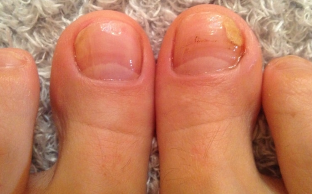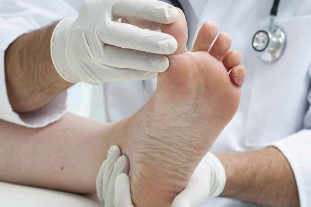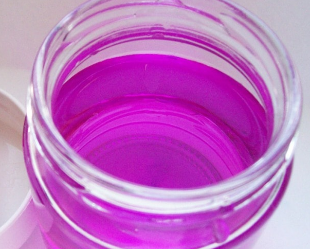Darkening of the nail plate, its thickening, volume, and deformation – all of which can be a sign of the development of nail fungus (onychomycosis). Many patients confuse an infection with injury or psoriasis. To prevent worsening of the disease, it is necessary to know how to identify fungus on the nails on your feet, its types and symptoms.
Types of nail fungus

Most often, a fungal infection spreads not only on the nails, but affects about-the nail zone. Also suffer from the skin of the forefoot and interdigital folds of the hands and feet (mycosis). Among the most meet of pathogenic organisms that cause negative changes, that it is possible to allocate:
- yeast fungi – attack the nails, so it is thinner, which leads to the gradual separation of plate from bed;
- dermatophytes – penetrates into the stratum corneum of the epidermis, provoking the emergence of it in yellow stripes or spots of white paint, which over time grow bigger;
- stale sponge – penetrates into the upper layer of the plate and changes its color to green, gray or black.
When the infection affects the toenails, in the initial stages are already visible the first changes on the basis of which one can distinguish 3 basic types of mold.
- The distal onychomycosis. Defeat begins with the edge of the stratum corneum, and then the infection moves to the base of the plate. The nail becomes a grayish hue, with thickened or thinner out, crumble and eventually almost completely destroyed.
- Proximal sponge. It spreads from the center of the plate, to provoke the darkening and destruction.
- Superficial onychomycosis. It is accompanied by the emergence of white spots in the center of the nail, or at its edges. In the beginning of the disease the board does not have voltage, but to the touch is noticeable its friability, it eventually leads to a change of beds and the loss of the nail.
The first signs and symptoms of nail fungus
The development of mold and mildew, does not leak hidden. Already a few days after penetration of the infection appear the first symptoms that eventually become clearer.
- Nail dimmed, loses its luster, changing the image of the plate, appear yellow or white dots, longitudinal stripes.
- Changing the shape of the nail, leads to its deformation, which is accompanied by a thickening or thinning of the stratum corneum. Such a condition leads to a gradual separation, depletion plates, and further turning her out of bed.
- Arise from feelings of pain at the pressure. The Stratum corneum and the surrounding tissue to become inflamed.
- The emergence of diaper rash between the toes and the smell from the affected nails.

These symptoms and signs help to recognize nail fungus in the early stages and distinguish it from other diseases (bruises, psoriasis, eczema, herpes).
Methods of diagnosis
The procedure of identification of onychomycosis or mycosis usually goes through several stages, which include certain methods: the clinical picture, microscopy.
Originally, the specialist draws attention to the symptoms and complaints of the patient, performs the collection of clinical data. After inspection of the nail plate and the skin around them the doctor of pre-bringing of the infection, eliminates the similar diseases (psoriasis, red haze, problems with the normal nutrition of the nails).
For accurate confirmation of the disease, the specialist makes a fence material, in order to perform a microscopic examination. Of the affected area is used for scraping tissue and in the laboratory it is processed by special substance.
More accurately diagnose the type of mold helps in the study of biological material. The analysis is carried out after the microscopy. Carried out sowing scraping. A sample of the affected tissue is placed on the maintenance for the mold environment. After 3-5 days you can get the results of the procedure. The appearance of mold and mildew manage to figure out the structure of the colonies, their specific growth and specific color.
Thanks to a biological research to accurately identify the type of the virus and its sensitivity to certain antibacterial drugs. It allows not only to reveal the exact causative agent of the infection, but also to pick up effective treatment.
How to identify nail fungus at home?
Darkening of the nail plate, its friability and exhaustion are not always able to testify about onychomycosis. If you want to find out whether it is fungal infection, you can use iodine and potassium permanganate.
We define onychomycosis using potassium permanganate
The procedure to detect the fungus takes little time and is very simple in execution. In a basin with warm water is necessary to dilute a little bit of manganese, we have a weak solution. Place into the liquid hands or legs, wait for 5-10 minutes. In that time, healthy nails turns into a brown color, the affected areas will remain unchanged.
Identification of nail fungus using iodine
Unlike manganese, iodine can point to the presence of pathogens of onychomycosis. A means of helping to exclude other fungi, particularly tinea herpes. If the skin around the nails have emerged flaking, redness, it is worth such a zone to process iodine. Healthy skin is practically not will be darker under the alcoholic solution, and this is the reason that that the affected sites will be saturated dark colors.
How to distinguish mycosis of the nails from other diseases?
In the early stages of development, the fungal infection can be confused with skin diseases (psoriasis, shingles), or trauma of the nail. To run negative manifestations, it is important to know the basic differences mycosis.

- Darkening of the nail plate, the appearance of yellow spots and longitudinal streaks, which over time become more and penetrate deeper into the nail.
- The smooth development of the disease without exacerbations and peace of mind, as it goes with psoriasis. The fungus gradually causes the nail plate, and it's up to its delamination from the bed.
- The emergence of unpleasant odors and painful sensations, also distinguishes fungi from bruises or psoriatic lesions, eczema, herpes.
- The causes of the mold may be visits to public places (pool, sauna), wearing tight shoes (microtrauma and scuff), excessive sweating of the feet, diaper rash, as well as contact with an infected person.
- The fungus initially appears in one particular of the finger, most commonly large, then it affects the rest of the phalanges and interdigital zones.
These differences help to identify the fungus at the early stages of its development. Most importantly, remember that self-diagnosis is not enough. For effective treatment is the need examination from an expert.
Thrush – unpleasant and insidious disease, which can masquerade as other diseases (psoriasis, eczema). It is important to carefully monitor the nails and feet, and when suspicious symptoms in time to contact your doctor for timely treatment.





























